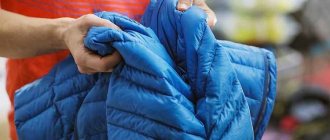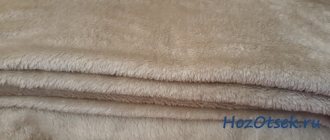So, in front of you is a wonderful modern washing machine, you are happy about it, and, of course, you are too. But when you start using it, you are surprised that out of 12 washing modes you actually use only 5: everyday, mixed, delicate, wool and quick. All other options are left out. This is partly understandable, because we don’t wash, for example, outerwear or duvets every day, and partly due to the fact that the names of the modes are completely incomprehensible. Let's try to figure out what's what and why.
Of course, different manufacturers call their modes differently, but all types of washing can be divided into three groups:
- programs whose characteristics vary depending on the type of laundry;
- programs aimed at saving (water or electricity - it doesn’t matter);
- programs that care about health (for example, washing for allergy sufferers, for children, washing with hot water, etc.).
Cotton
Brian A Jackson / Shutterstock.com
How to wash
Products made from thick cotton fabric can be washed at temperatures up to 95 °C, but it is better to experiment with hot water less often, otherwise the fibers of the fabric will quickly break down and a hole will appear on your favorite shirt.
White items can be washed at temperatures up to 65 °C; for colored items, temperatures between 30 and 40 °C are suitable (clothes may fade when washed in hot water). The optimal spin mode is up to 800 rpm. Wash colored and white items separately. Before putting your clothes in the machine, check to see if they are fading. Wet a corner or inner seam of the product with soapy water and run a dry cotton pad over it. If a distinct color mark remains on it, it is better to wash this item by hand.
Before washing, soak stained clothes in warm water with added stain remover. It is better not to soak colored items for a long time, otherwise the fabric will lose its brightness.
How to dry
After washing, shake clothes to remove wrinkles and hang them on a clothes line or drying rack. Thick cotton items can be put in the dryer: this will make your favorite terry robe soft even without conditioner.
Cotton knits should dry on a flat surface, such as a clothes dryer covered with a towel. Hanging a wet cotton sweater on a line can cause it to stretch and lose its shape.
Do not over-dry cotton clothes, otherwise you will have trouble ironing out creases in the fabric. If the item still takes too long to dry, spray it with water before ironing. Cotton can be ironed at high temperature with steam.
To make things dry faster and softer, you can get a drying machine. You simply load the laundry into the drum and take it out warm and dry. Such devices do not take up much space: the Italian brand Candy has a narrow model that easily fits into cramped closets, closets or small bathrooms. It can even be installed directly on the washing machine.
Candy dryers are equipped with a special reservoir to collect water, so they do not need to be connected to a drain. If you wash and dry things every day, you don’t have to worry about bills: the device runs on a heat pump and uses energy sparingly.
To learn more
How to properly load clothes into a washing machine
Do not store dirty laundry in the washing machine. Harmful microorganisms may grow in the drum.
Distribute the items evenly throughout the drum. Do not add more laundry than stated in the instructions. If you fill the machine too much, the clothes will not wash well. Cotton and linen clothes pass water well, so the drum can be completely filled with it.
When washing sportswear and other items made from synthetic fabrics, fill the drum no more than halfway. Synthetics do not absorb moisture well. To wash it, you will need more water.
When washing delicate items made of silk and wool, it is better to fill the drum only one-third full. This way the clothes will float freely in the water and the walls of the drum will not injure them.
Down jackets
How to wash
First of all, study the information on the sew-in label: your down jacket may only be suitable for dry cleaning. If you can wash it, unfasten the hood and remove the fur. Check if there are any holes in the pockets or lining, otherwise after washing you will have to scoop out the runaway filler from the machine.
Fasten the down jacket with a zipper and buttons, turn it inside out and put it in the machine with a couple of wash balls. You can use regular tennis balls instead. They will not allow the filler to clump together.
For washing, it is better to use a special liquid detergent: regular powder is more difficult to rinse out and leaves streaks on the fabric. Wash the down jacket at a temperature not exceeding 30 °C with an additional rinse, and set the spin cycle to 600 rpm.
How to dry
After washing, unfasten the fasteners and turn the down jacket right side out. You can dry it on a hanger, but you will have to shake the jacket periodically, whipping up the filler.
If the apartment is cool, a jacket with natural down will take a long time to dry, and the filling will begin to rot. In this case, a dryer will help out: you can dry your jacket in it at a minimum temperature. Pre-wring the item by hand or in the washing machine so that water does not drip from the down jacket.
Washing rules
- Be sure to sort your laundry by fabric type and color. It is convenient to do this in advance by dividing the dirty laundry basket into compartments (plastic dividers are sold in hardware stores). This way you will save time and will be spared the need to dig through dirty laundry.
- Be careful when choosing a detergent. It is optimal to have in your home not only general-purpose powder, but also detergents for wool and silk, sports and membrane fabrics, as well as bleach. It is enough to turn black items inside out before washing, as modern dyes do not fade so easily.
- Try to choose the right washing mode, temperature and spin speed. As already mentioned, it is necessary to focus on the labels that clothing manufacturers always supply their products with, but if such information is not available, you can use the recommendations above.
- Use fabric softener - it will make your towels soft and your bed linen can be ironed easily. If you use specialized products when washing wool or silk, rinse aid is usually not used.
- Keep in mind: if you wash only at low temperatures, the machine may “bloom”, that is, black mold will appear in it, and a putrid smell will appear, which will be transmitted to the laundry. To prevent this from happening, thoroughly dry the detergent tray, wipe the rubber gaskets between the drum door and the machine body, and wash at high temperature at least once a month.
Wool
Rossella/Shutterstock.com
How to wash
Clothes made of wool are difficult to care for: if you wash your favorite sweater in too hot water, it will shrink by several sizes, and you won’t be able to restore its original appearance. For some items, washing is completely contraindicated - for example, it is better to dry-clean a cashmere jacket, otherwise you can say goodbye to it right away.
Woolen clothes should be washed on a delicate cycle so that the water temperature does not exceed 30 °C. You can spin such things in the machine only at minimum speed.
For washing, do not use powder, but special delicate products: they will carefully remove dirt and soften the fibers so that the clothes do not prick. In a pinch, a mild shampoo will do, but then you will have to add an extra rinse cycle.
How to dry
After washing, do not twist woolen clothes by hand: rough handling will cause them to lose their shape. To remove excess water, place the sweater on a clean terry towel, roll it up and roll it. The towel will absorb water, and the sweater will dry faster after this procedure.
To prevent wool items from stretching, dry them on a horizontal surface. You can use a tumble dryer, but make sure it has the appropriate setting. If the image of a dryer is crossed out on a clothing label, it is better not to take risks: the item may become covered with pills or shrink in size. Wool absorbs odors perfectly, so things should dry in a well-ventilated area away from the kitchen.
It is better to iron at a minimum temperature, turning the clothes inside out. To prevent shiny marks from appearing on the fabric, it should be ironed through damp gauze, carefully applying the iron.
Additional functions
Most modern models of automatic machines contain a large set of additional functions that help solve all problems and satisfy the various requirements of housewives.
Delay mode
A convenient way to turn on the washing machine before going to work and take out the finished clothes when you come home in the evening. At the same time, they will not wait for the owner in the drum for several hours, already washed (crumpled and compressed).
It is important to load the detergent completely and set the clock to a delay start mode.
You need to read the instructions for the washing machine. First we set the current time and then program it for the desired turn-on time.
See also
How to properly wash jeans by hand and in a washing machine, temperature and mode
Video on how to delay automatic washing
Night
When using the night mode, the sound signal is turned off, as well as the spin cycle, which is noisy and can wake up household members and neighbors.
Water level control
When monitoring the required amount of water, the machine itself decides how much liquid to pour into the drum based on the weight and volume of the load in order to better wash and rinse things.
Spin balancing
The mode ensures uniform distribution of laundry during spinning and, if necessary, slows down the rotation of the drum by adjusting the speed. A very convenient tool for heavy loads, it prevents excessive vibration and movement of the device from its place.
Water clarity control
This mode is convenient to use for children's clothing and if household members are allergic to detergents. The machine determines whether the items have been rinsed sufficiently or whether the water is not clear enough and contains soap. If necessary, perform additional rinsing.
Spin
The function allows you to simply spin out wet items by selecting the spin force (rpm). You can quickly spin out hand-washed items, as well as those that did not leave the machine dry enough.
Drain
This function allows for simple (without additional operations) removal of water from the drum. For example, when a program crashes and things are retrieved.
Rinse and drain
A convenient way to simply rinse things and drain the water. Can be used if bad powder remains on the laundry after washing and rinsing.
Disabling spin
It is necessary to turn off the spin cycle when washing many items. For example, it is recommended not to wring linen items to avoid severe creasing, which makes ironing difficult. The machine simply washes, rinses and drains the water.
Extra rinse
The function allows you to rinse things more efficiently by adding water again and performing a full rinse cycle.
Easy ironing
Things wrinkle in the drum, mainly when spinning at high speeds. This mode (anti-crease protection) makes the push-up less aggressive and reduces the drum rotation speed. The laundry wrinkles less, but is less dry. You will have to dry it yourself, but it will be easier to iron.
Foam control
Excess foam does not affect the quality of washing, but simply clogs things with excess detergents. In this mode, excess foam formed during spinning and deposited on things is removed from the drum using a special pump.
Troubleshooting
A convenient feature that allows the washing module to identify its own problems. The operation of various parts of the device is tested and a fault code is displayed. The instructions usually indicate what problem the code corresponds to and how to fix it.
Denim
Tomo Jesenicnik / Shutterstock.com
How to wash
Jeans can easily be machine washed at temperatures up to 40°C. To prevent them from fading, it is better to use a liquid product for colored items. The spin can be set to 600 rpm, and even a mode with 800 rpm is suitable for thick fabrics.
If your jeans are downright dirty, before washing, soak them for half an hour in warm water with the addition of a special product. Gently rub the stained areas and put them in the machine. You shouldn’t leave jeans in a basin of water all day: there is a risk that the fabric will fade and rust will appear on the fittings.
Before putting the item in the machine, fasten the zipper and button, turn it inside out and make sure there is nothing in the pockets. New jeans may fade at first, so wash them separately from other items.
How to dry
It is better to dry jeans vertically, hanging them from the belt. Straighten them first so that there are no obvious creases. Denim fabric is not particularly demanding, so you can put such items in the dryer.
If your trousers are a little short, there is a way to slightly increase their length. Step on the bottom edge of your wet jeans, take the waistband in your hands and gently pull it up. Repeat the procedure a couple of times, and then hang the item to dry.
Tight trousers don’t need to be ironed at all after washing; they will straighten out perfectly on the body. It is better to iron straight and flared models from the inside out in a mode suitable for cotton.
Frequency of bed linen change
Many people still don't know how often to wash their bedding. They believe this: if there are no obvious signs of contamination that are visible to the naked eye, then the laundry is clean. Therefore, they wash it once every 2-3 weeks . In fact, this is wrong. Sheets and duvet covers get dirty quickly, so they must be replaced and washed at least once a week.
With pillowcases the situation is worse. They immediately absorb hair oil, night creams and other cosmetics used for hair and facial skin. After 2-3 days, the pillowcase should be changed and washed.
Synthetics
How to wash
It is recommended to machine wash synthetic clothing on a delicate cycle. Items made from fabric that imitates silk are best placed in laundry bags to prevent puffs from appearing. The suitable temperature is 30–40 °C, and the maximum permissible spin mode is 600 rpm. You can add a conditioner with an antistatic effect to the powder: this will prevent clothes from sticking to the body and causing electric shock.
Wash fleece items with liquid detergents and do not wring them either in a machine or by hand. Let the water drain and hang the clothes to dry. It will dry quickly even without pre-twisting.
Membrane items like jackets and ski pants can be machine washed, but you need to be careful. Set to a delicate cycle with minimal spin, and for washing, use only products intended for membrane fabric.
How to dry
Hang synthetic shirts and blouses on the clothes dryer, while jumpers and cardigans should dry flat to maintain their shape. Synthetics can be put in the dryer, but make sure it has the appropriate setting. Such fabrics are afraid of hot water and air, so the device must handle them extremely gently.
You can iron synthetics at a minimum temperature, otherwise the fabric may melt. It is better to iron things from the inside out and only through gauze - it can be slightly moistened to quickly smooth out the wrinkles.
Silk
Ben Bryant / Shutterstock.com
How to wash
Natural silk is a capricious fabric, so it is better to wash such clothes by hand. Forget about bleaches and harsh stain removers, they can ruin things. For washing, use special gels for delicate fabrics or regular shampoo.
Silk is suitable for water temperatures up to 40 °C. Soak the clothes for a maximum of 15 minutes and wash carefully, do not rub with all your might or stretch the fabric. Rinse your clothes thoroughly to ensure they are streak-free after drying. You need to rinse several times, gradually reducing the water temperature.
How to dry
Silk should not be twisted: wet fabric can be easily damaged. Wring out gently, let the water drain, and then dry the item with a terry towel (like wool items).
It is better to dry silk clothes in a horizontal position. You can use a clothes dryer or a clothesline, but then you should put a layer of thick fabric (at least the same terry towel) under the clothes. Clothespins are prohibited; they will leave traces.
Iron silk clothes at minimum temperature from the inside out. You should not steam or spray it with water: stains and streaks will appear. To get rid of them, you will have to wash and dry the item again. After ironing the product, let it cool, otherwise wrinkles will appear again.
Linen
How to wash
Undyed linen can be washed at temperatures up to 90°C, while colored items are suitable for cooler water – 30–40°C. Such things can withstand spinning at 600 rpm, but you shouldn’t twist them by hand: you can overdo it and stretch or tear the fabric.
Chlorine bleaches are not suitable for linen. If you need to remove a stubborn stain, use oxygen products. Soak your clothes with them before washing and set the extra rinse mode.
If there is embroidery on a linen item, it is better not to take risks and wash such a product by hand so that it does not fade. You cannot soak the area with the pattern for a long time and vigorously rub it, as you will only ruin the clothes.











